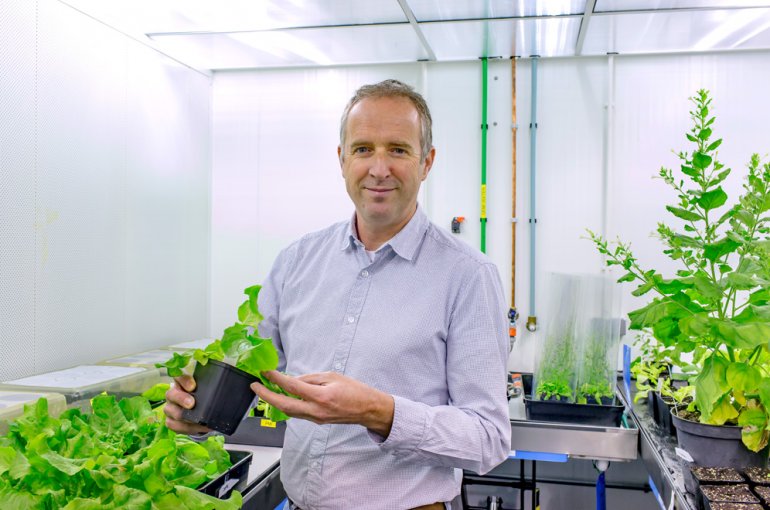“I’ve noticed that companies are very open to contact, and urgently need new ideas for disease resistance. Collaborating with them provides us with knowledge gained in the field and materials that we can use in our fundamental research”, says Van den Ackerveken. “It’s a win-win situation.”
Translational research
“Plant diseases present a tremendous problem to agricultural and food production, so it is of prime importance to find sustainable ways to combat pathogens. Through our research, we aim to contribute knowledge that can be translated to optimise the plant’s immune system and find other innovative ways to fend off pathogens. And by identifying and using beneficial microbes, we can develop strategies that may lead to reduction in the use of agro-chemicals. To that end, my group collaborates with companies in many projects to find new breeding strategies to enhance resistance to important crop diseases. Going from scientific discoveries to their application in practice is what I call translational research.”
Do not become narrow-minded
“Interactions between microorganisms and their host plants are fascinating to study, as they communicate, influence and even manipulate each other. Therefore, one first needs to know how they function as individual organisms. In addition, to be successful in this field of research, you have to be familiar with microbiology, plant biology, genetics, biochemistry, molecular biology and bioinformatics. So in my opinion, a broad interest is vital in this field of research, because we need to study both the plant and microbe sides of the problem at different levels in order to grasp what happens during their interactions, such as infections in diseased plants.
Ever since my PhD, I have always worked on both the microbe- as well as the plant-sides of the interaction. My PhD research and my first post-doc project in Wageningen were on fungal-secreted proteins that trigger immunity in tomato. As a member of the group led by Ulla Bonas in France, I worked as a postdoc on bacterial plant pathogens, type 3 secretion and effector proteins, now known as TALEs, which sparked a revolution in genome editing before the introduction of CRISPR/Cas9. After a brief time working in Germany, I soon got the opportunity to start my own research group at Utrecht University. As I was very interested to work on the Arabidopsis model system, Utrecht was a perfect place.”
Bioinformatics revolution
“Without bioinformatics, we would not be able to analyse the large data sets that we are working with. We also make good use of the UBC’s High Performance Computing facility. Important data sources include RNA sequences from infected plant samples and genome sequences of pathogenic microbes. Microbiome analysis and metagenome sequencing have also received a boost recently. We are lucky to have so much bioinformatics expertise in Utrecht, and so many researchers who are open to collaborate and share analysis expertise.
I remember well that in order to analyse DNA data during my PhD project in Wageningen, we had to dial into the CAOS/CAMM VAX computer in Nijmegen to use the GCG package for basic DNA analysis there. You could say that this was my first encounter with basic bioinformatics. In 2000, the high-quality Arabidopsis genome was published, making this model plant a great system for genomics and bioinformatic approaches. One of our major contributions to bioinformatics was the development of expression QTL (eQTL) analysis to unravel regulatory networks (Keurentjens et al., PNAS, 2007). Bioinformatics is also indispensible for the analysis of plant pathogen genomes, and it allows us to identify important virulence genes.”
Bridging computational analysis
“From the start, I have been a big supporter of the initiative for the Utrecht Bioinformatics Center, and I am very happy with the way the UBC operates in Utrecht. It has helped enormously in developing a strong bioinformatics teaching programme, as well as a community bringing together researchers who share a common interest in the computational analysis of their data. For example, we have set up a strong infrastructure for bioinformatic analysis of plant and microbe genomics data together with other groups within the IEB. A dedicated bioinformatician, Basten Snoek, working in the Bioinformatics group led by Prof. Berend Snel, supports the IEB researchers in their bioinformatic analyses.”
Invest in bioinformatics skills
“I have some advice for the MSc and PhD students, our younger fellow researchers: invest in your bioinformatics skills. It will take some time and perseverance in the beginning, but you will soon realise that knowing how to work and be comfortable with big data sets is a great asset. I am happy to see that many new students now follow the bioinformatics profile and utilise their skills in combination with wet lab research … That’s great!”
Note: Utrecht plant biologists have again been successful in setting up consortia of researchers and private partners, and in applying for research funding to develop the basis for a ground-breaking system change aimed at realising resilient and sustainable plant production systems.
Read more on the website of Utrecht University.

